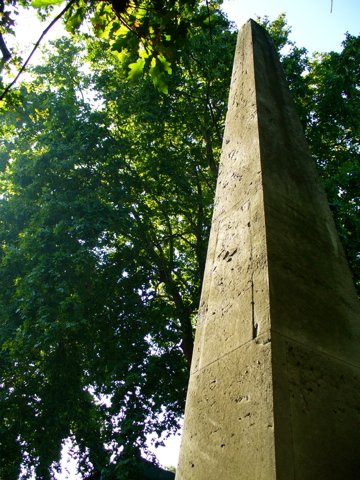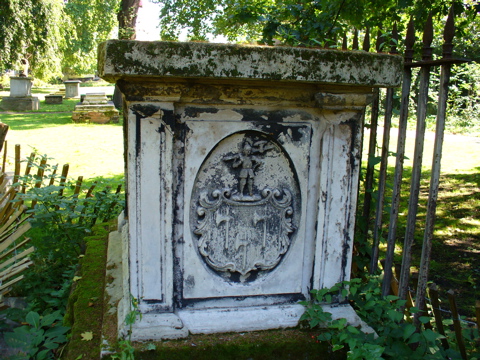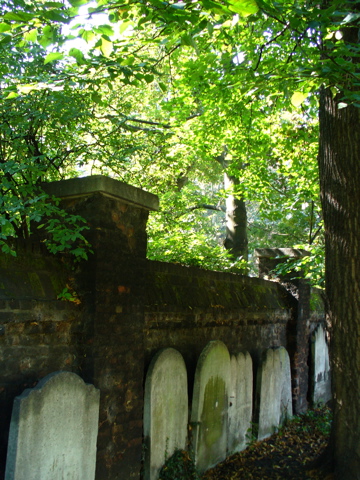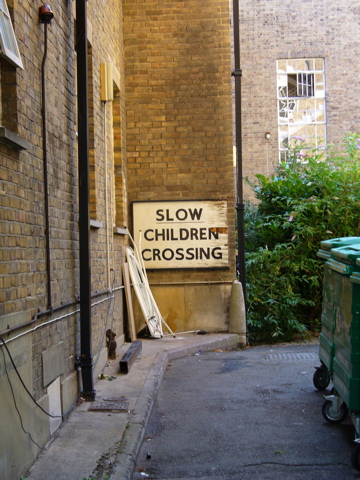
I’ve nearly finished with my long series of London posts, but I’ve got a couple more before I recount my travels in the provinces. This one is about Bloomsbury, my home for two months in the (northern) summer of 2007; I really took to it. I’ve written about some of Bloomsbury’s sights before (Charles Fort’s house, Mecklenburgh Square, St Pancras Parish Church, and of course the British Museum). Here are a few more.
Above is Euterpe, the Muse of music. Between 1898 and 1961 she graced the facade of the Apollo Inn on Tottenham Court Road.

Bloomsbury is famous for its garden squares. But my favourite Bloomsbury garden isn’t a square at all, but a former graveyard: St George’s Gardens (where Euterpe can now be seen). It’s much more secluded and peaceful than the squares, because it is surrounded on all sides by houses instead of roads, and there are usually far less people than Russell Square or somewhere like that. The remaining tombs and headstones give it a wonderfully melancholic air. It’s a nice place to sit and read, or just to walk through; luckily it’s on the way from Mecklenburgh Square to St Pancras so I got to do this quite a lot.
The tomb in the foreground is that of Anna Gibson (1659-1727), sixth and favourite daughter of Richard Cromwell, the second and last Lord Protector of England, Scotland and Ireland.

I think the human remains have been removed. It was in use as a cemetery (one of the first not adjacent to a church) from some time after 1713 until 1855 when it was too crowded with the dead to take any more. A few decades later it was reopened as a green space for the urban poor.

An obelisk by (or for?) Thomas Falconer, dated 1729.

Presumably the family coat of arms of whoever was buried here. Obviously really fond of their halberds.

I’m glad to see that St George’s Gardens has Friends. Here’s how Betty Szarowicz, who was born in 1915 and grew up nearby, remembered it:
We were 5 children, house shared, no facilities, a yard for hanging the washing (but we did eventually grow a small cherry tree there), and so gardens were very important to me.
We knew all the Parks (the Squares were closed when we were children)…but St George’s Gardens was very special, magical, and we spent a lot of time there because we could go alone, being nearby.
We acknowledged the tombs, whispering when passing out of reverence, but I never thought of it as being a burial place, it was simply called “the gardens”.
‘[V]ery special, magical’ — sounds about right!
Moving on from the gardens now … though this next one is actually very close to the south-east gate:

Seems a bit harsh.

Ah, the British Library, or ‘BL’ as we old hands like to call it. I think it’s spoiled me, as far as libraries are concerned; I went to the State Library last week, for the first time since I got back, and it just wasn’t the same. I almost missed having to check with a librarian whether I’m allowed to photocopy something, or having to open my laptop so a security guard can make sure I wasn’t smuggling anything out. Almost.
My prized 3-year BL reader’s pass expires in July 2010; I wonder if I’ll get to use it again?

Russell Square tube was the closest station to me, though if I didn’t want the Piccadilly Line, Kings Cross St Pancras was often the better bet, since it was only a few minutes further away on foot.

The northbound (I think) platform at Russell Square. This was an air raid shelter during the Blitz (of course, so were most of the other tube stations). As Constance Holt later recalled, it was still being used as a station as well.
Most of the tube stations were taken over as shelters, as there weren’t enough big public shelters that people could get to. Russell Square Station was one of these. I remember on several occasions coming back from the theatre by tube, and when I got out at Russell Square they had put bunks all along the platform, and you’d see women putting on their face-cream, doing up their curlers and getting right for the night. Of course you’d politely not stare at them because they were in their bedrooms. I remember there was a little bit of snobbery about stations. I heard one woman say, ‘Oh, us and our family go to Regent’s Park now, it’s nicer people.’ And the children used to go for rides on the tube. At least their mothers knew where they were, and it was much safer than the street.
The fact that bunks were put up indicates that this was later on in the Blitz, because the government initially tried to discourage people from using tube stations as shelters, fearing that once people went down, they’d stay there.

Finally, the memorial at Tavistock Square to the 13 people (including Sam Ly, a fellow Melburnian) killed by a bomb on a bus near here on 7 July 2005. I arrived in Bloomsbury on the day after the second anniversary of the terrorist attacks, and the crowds of people gathered around the various floral memorials were hard to miss. The three bombers on the Underground all diverged from Kings Cross St Pancras; one detonated his bomb between there and Russell Square. And Tavistock Square is just north of Russell Square.
So my personal geography overlapped that of the terror attacks, and as my research is all about fear, panic, terror, Bloomsbury was an oddly appropriate place to stay.
![]() This work is licensed under a Creative Commons Attribution-NonCommercial-NoDerivatives 4.0 International License.
Permissions beyond the scope of this license may be available at http://airminded.org/copyright/.
This work is licensed under a Creative Commons Attribution-NonCommercial-NoDerivatives 4.0 International License.
Permissions beyond the scope of this license may be available at http://airminded.org/copyright/.
